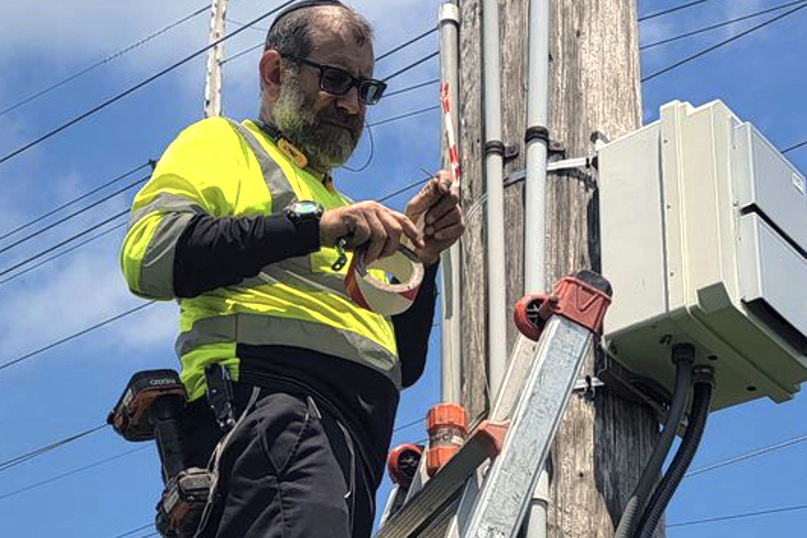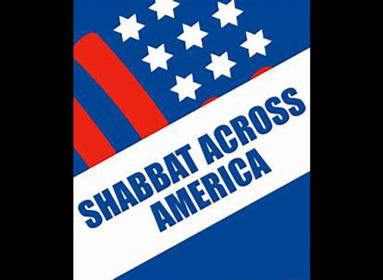
By Stacey Dresner
HARTFORD – Observing Shabbat at the University of Hartford has become much easier with the addition of a new eruv surrounding the West Hartford campus and the Rohr Chabad Jewish Center, which lies adjacent to the campus.
An eruv is a physical boundary allowing observant Jews to carry certain objects on Shabbat.
Under Jewish law, it is forbidden to carry any item – even things like siddurim, tallit bags and house keys (or to push a baby stroller) – from a private or enclosed area (one’s home) to a public area – for example, along a public street.
In the past, Jews often lived in cities and communities that were enclosed by walls. Those closed-in communities were seen as private domains, allowing the Sabbath observer to carry necessary items on Shabbat.
Today, in more spread-out areas like West Hartford, an eruv often consists of long wires connected high up on telephone or electrical poles, which are considered the “walls” of the eruv.
“The way it typically works is, you try to find natural barriers/utility poles and lines that kind of naturally give a boundary to a certain area. And we then say that everybody living inside that area is one community, one family,” explains Rabbi Yossi Kulek, director of Chabad Chevra at the University of Hartford.
“We’re saying we’re together, versus being single individuals with no connection with one another. What I love about the eruv in general is it brings the community together, connecting everybody in the eruv to make them really part of one big family,” he says.
The new eruv encircles the Rohr Chabad Jewish Center on Bloomfield Avenue in Hartford – Chabad Chevra’s headquarters – and the University of Hartford campus down the street, via the Watkinson School, which is located between Chabad and the university.

Photo by Stacey Dresner
The idea to install an eruv began back in 2010. The Rohr Center had just opened the year before, and Rabbbi Kulek sat down to discuss the idea of building an eruv with University of Hartford’s past president Walter Harrison.
“The university was supportive right from the beginning and they gave me the go ahead,” Kulek says.
Kulek also went to Rabbi Brahm Weinberg, then spiritual leader of Young Israel of West Hartford, who oversaw the West Hartford eruv already in place around Albany Avenue.
“We surveyed the campus and saw that this was really doable, but we realized it was a much bigger project than we thought,” Kulek notes. “At that point, we thought that the university was surrounded on three sides by natural barriers, and we figured, okay, well, we’ll finish it. But it required money and getting the right experts to come do it, and we were just trying to keep the Chabad Chevra activities going and so on and so forth, so it wasn’t within the budget at the time.”
Enter Eliana Lebson, a senior at the university, who first emailed Kulek when she was a freshman to suggest there needed to be an eruv at the school.
Lebson stressed the difficulties she experienced observing Shabbat on the University of Hartford campus without an eruv.
“We need our ID to get back on to campus. I could never show it, but at some point they started to recognize me. And the keys to my dorm were very difficult to figure out,” she said. “I remember in my freshman year I wanted to carry a water bottle because I was walking around in the sun. I couldn’t do that. I couldn’t carry a book with me. If I was walking somewhere in a mask, I had to keep it on. I couldn’t take it off and hold it in my hands. And sweatshirts – that was a big one.”
“Pretty much every observant student at the University of Hartford comes here Friday night and for Shabbat lunch, and that’s a big deal for them,” adds the rabbi. “So that has been a dilemma.”
About a year ago, as she entered her senior year, Lebson approached Kulek again.
“All last year I was bothering him about it. I said, ‘Let’s get on this!’ And he agreed,” she reports. “I don’t think they thought I could raise the money, but I was confident.”
Lebson spearheaded the fundraising effort and began raising money last winter break.
“She is a hard worker!” Kulek marvels.
Lebson began emailing as many people as she could, including old high school and NCSY friends. She gathered email lists of people in the local Jewish community and even got her grandfather, Rabbi Richard Plavin of Manchester to help contact fellow rabbis and philanthropists in the area.
In all more than $15,000 has been raised for the eruv, which in addition to building the structure, will also help to cover continuing maintenance costs.
But raising funds was just the first step.
Installing and maintaining an eruv can be a complicated business – figuring out what natural barriers, i.e.: fencing or utility poles can be used; getting permission from landowners and authorities; and figuring out where to place additional poles, to name a few considerations.
“When we started looking at it now, 10, 11 years later, we realized that the university had actually reconfigured a major portion of the wiring of their electrical lines. So, on one side that we were relying on we had a lot more work to do,” Rabbi Kulek explains. “There were areas where we had to put up poles. There were areas where we needed to literally connect existing light poles with wire… There’s also conduits we had to put up and we had to put on these markings to tie it all together.”
Another issue was that the utility poles on Bloomfield Avenue are on the inner side of the sidewalk so they would not be inside the eruv.
“The only way it would work was to put poles on the Watkinson property because that would then include a sidewalk and it wouldn’t be on neighbor’s property,” Kulek explains.
Chris DuPois, operations director at the University of Hartford made a ‘shidduch’ between the rabbi and John O’Lear, head of grounds and operations at Watkinson.
O’Lear worked with Chabad and got approval from the Watkinson board of trustees to allow the eruv to be constructed on their property.
“They were very supportive of the idea from the start,” Rabbi Kulek notes.
Rabbi Tuvia Brander of Young Israel of West Hartford introduced Kulek to Rabbi Micah Shotkin, a nationally-known eruv expert came on board the project, surveying the area involved and explaining step by step what needed to be done to get the eruv installed. Shotkin could be seen at times stating in his “cherry-picker,” working to get the eruv wires installed.
Despite a few hitches, the eruv, was up and running the day before Yom Kippur of this year.
“It was really a community wide project,” says Kulek. “From the past university administration to the new administration to the Office of Student Affairs and the Office of Engagement and Inclusion, they were very supportive. I had a meeting over the summer with Aaron Isaacs, the dean of students, and he said, ‘Let’s make it happen.’ They came up with some funds as well. They all had to come together and they did, and they made it easy.”
Eliana Lebson is happy to have the eruv up and running, but she will graduate from the University of Hartford with a degree in media arts in May so she will not have had the opportunity to make use of it for too long.
“Yes, it’s for me, but I also want to make this a place where more Modern Orthodox students can go to, because it’s a great place and that is something that will help anyone who wants to come here.”
Main Photo: Rabbi Micah Shotkin working on repairing a wire on the University of Hartford-Chabad Chevra eruv.Photo courtesy of chabad chevra.







 Southern New England Jewish Ledger
Southern New England Jewish Ledger













